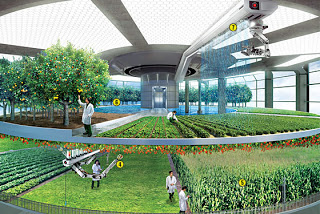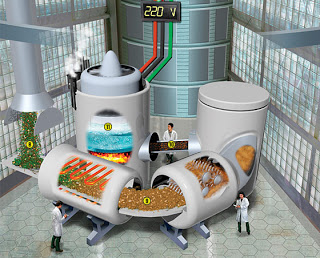Agriculture
1. The Solar Panel
Most of the vertical farm?s energy is supplied by the pellet power system (see over). This solar panel rotates to follow the sun and would drive the interior cooling system, which is used most when the sun?s heat is greatest.
2. The Wind Spire
An alternative (or a complement) to solar power, conceived by an engineering professor at Cleveland State University. Conventional windmills are too large for cities; the wind spire uses small blades to turn air upward, like a screw.
3. The Glass Panels
A clear coating of titanium oxide collects pollutants and prevents rain from beading; the rain slides down the glass, maximizing light and cleaning the pollutants. Troughs collect runoff for filtration.
4. The Control Room
The vertical-farm environment is regulated from here, allowing for year-round, 24-hour crop cultivation.
5. The Architecture
Inspired by the Capitol Records building in Hollywood. Circular design uses space most efficiently and allows maximum light into the center. Modular floors stack like poker chips for flexibility.
6. The Crops
The vertical farm could grow fruits, vegetables, grains, and even fish, poultry, and pigs. Enough, Despommier estimates, to feed 50,000 people annually.

The vertical farm doesn?t just grow crops indoors; it also generates its own power from waste and cleans up sewage water.
1. The Evapotranspiration Recovery System
Nestled inside the ceiling of each floor, its pipes collect moisture, which can be bottled and sold.
2. The Pipes
Work much like a cold bottle of Coke that ?sweats? on a hot day: Super-cool fluid attracts plant water vapors, which are then collected as they drip off (similar systems are in use on a small scale). Despommier estimates that one vertical farm could capture 60 million gallons of water a year.
3. Black-Water Treatment System
Wastewater taken from the city?s sewage system is treated through a series of filters, then sterilized, yielding gray water?which is not drinkable but can be used for irrigation. (Currently, the city throws 1.4 billion gallons of treated wastewater into the rivers each day.) The Solaire building in Battery Park City already uses a system like this.

4. The Crop Picker
Monitors fruits and vegetables with an electronic eye. Current technology, called a Reflectometer, uses color detection to test ripeness.
5. The Field
Maximization of space is critical, so in this rendering there are two layers of crops (and some hanging tomatoes). If small crops are planted, there might be up to ten layers per floor.
6. The Pool
Runoff from irrigation is collected here and piped to a filtration system.

7. The Feeder
Like an ink-jet printer, this dual-purpose mechanism directs programmed amounts of water and light to individual crops.
8. The Pellet Power System
Another source of power for the vertical farm, it turns nonedible plant matter (like corn husks, for example) into fuel. Could also process waste from New York?s 18,000 restaurants.
9 to 11. The Pellets
Plant waste is processed into powder (9), then condensed into clean-burning fuel pellets (10), which become steam power (11). At least 60 pellet mills in North America already produce more than 600,000 tons of fuel annually, and a 3,400-square-foot house in Idaho uses pellets to generate its own electricity.
- Financing And Benefits
If you are considering establishing up solar power panel technology for your city or agribusiness to reduce your power costs, you may be thinking if there are any benefits or funding solutions to help you get began. There are in fact many funding solutions...
- Vertical Farming | Creating The Fertile City
?Without artificial lighting the result will be an uneven crop, as plants closest to the windows are exposed to more sunlight and grow more quickly.? WHEN you run out of land in a crowded city, the solution is obvious: build upwards. This simple trick...
- Public Works: Vertical Farming
By Patrick Metzger A new breed of urban farm visionaries says "Go big, or go home."You?ve likely heard of the 100 mile diet: sourcing all your food from farmers within 100 miles of home. But what if you could keep the kids in comestibles from...
- Around The World On Solar Power Alone
Almost a year ago, the Turanor PlanetSolar, a sleek catamaran that bears a resemblance to a giant water beetle, set off from Monaco on a voyage around the globe. Later this month it will arrive in Singapore, having amassed proof that it is possible to...
- Sky Farming
By 2025, the world?s population will swell from 6.6 billion to 8 billion people. Climate simulations predict sustained drought for the American Midwest and giant swathes of farmland in Africa and Asia. Is mathematician Thomas Malthus?s 200-year-old prediction,...
Agriculture
Inside a Vertical Farm
1. The Solar Panel
Most of the vertical farm?s energy is supplied by the pellet power system (see over). This solar panel rotates to follow the sun and would drive the interior cooling system, which is used most when the sun?s heat is greatest.
 |
(Photo: Architectural Designs by Rolf Mohr) |
2. The Wind Spire
An alternative (or a complement) to solar power, conceived by an engineering professor at Cleveland State University. Conventional windmills are too large for cities; the wind spire uses small blades to turn air upward, like a screw.
3. The Glass Panels
A clear coating of titanium oxide collects pollutants and prevents rain from beading; the rain slides down the glass, maximizing light and cleaning the pollutants. Troughs collect runoff for filtration.
 |
(Photo: Interiors by James Nelms Digital Artist @ Storyboards Online) |
4. The Control Room
The vertical-farm environment is regulated from here, allowing for year-round, 24-hour crop cultivation.
5. The Architecture
Inspired by the Capitol Records building in Hollywood. Circular design uses space most efficiently and allows maximum light into the center. Modular floors stack like poker chips for flexibility.
6. The Crops
The vertical farm could grow fruits, vegetables, grains, and even fish, poultry, and pigs. Enough, Despommier estimates, to feed 50,000 people annually.

The vertical farm doesn?t just grow crops indoors; it also generates its own power from waste and cleans up sewage water.
1. The Evapotranspiration Recovery System
Nestled inside the ceiling of each floor, its pipes collect moisture, which can be bottled and sold.
2. The Pipes
Work much like a cold bottle of Coke that ?sweats? on a hot day: Super-cool fluid attracts plant water vapors, which are then collected as they drip off (similar systems are in use on a small scale). Despommier estimates that one vertical farm could capture 60 million gallons of water a year.
3. Black-Water Treatment System
Wastewater taken from the city?s sewage system is treated through a series of filters, then sterilized, yielding gray water?which is not drinkable but can be used for irrigation. (Currently, the city throws 1.4 billion gallons of treated wastewater into the rivers each day.) The Solaire building in Battery Park City already uses a system like this.

4. The Crop Picker
Monitors fruits and vegetables with an electronic eye. Current technology, called a Reflectometer, uses color detection to test ripeness.
5. The Field
Maximization of space is critical, so in this rendering there are two layers of crops (and some hanging tomatoes). If small crops are planted, there might be up to ten layers per floor.
6. The Pool
Runoff from irrigation is collected here and piped to a filtration system.

7. The Feeder
Like an ink-jet printer, this dual-purpose mechanism directs programmed amounts of water and light to individual crops.
8. The Pellet Power System
Another source of power for the vertical farm, it turns nonedible plant matter (like corn husks, for example) into fuel. Could also process waste from New York?s 18,000 restaurants.
9 to 11. The Pellets
Plant waste is processed into powder (9), then condensed into clean-burning fuel pellets (10), which become steam power (11). At least 60 pellet mills in North America already produce more than 600,000 tons of fuel annually, and a 3,400-square-foot house in Idaho uses pellets to generate its own electricity.
Concept design by Chris Jacobs for United Future.
source: New York News and Features
- Financing And Benefits
If you are considering establishing up solar power panel technology for your city or agribusiness to reduce your power costs, you may be thinking if there are any benefits or funding solutions to help you get began. There are in fact many funding solutions...
- Vertical Farming | Creating The Fertile City
?Without artificial lighting the result will be an uneven crop, as plants closest to the windows are exposed to more sunlight and grow more quickly.? WHEN you run out of land in a crowded city, the solution is obvious: build upwards. This simple trick...
- Public Works: Vertical Farming
By Patrick Metzger A new breed of urban farm visionaries says "Go big, or go home."You?ve likely heard of the 100 mile diet: sourcing all your food from farmers within 100 miles of home. But what if you could keep the kids in comestibles from...
- Around The World On Solar Power Alone
Almost a year ago, the Turanor PlanetSolar, a sleek catamaran that bears a resemblance to a giant water beetle, set off from Monaco on a voyage around the globe. Later this month it will arrive in Singapore, having amassed proof that it is possible to...
- Sky Farming
By 2025, the world?s population will swell from 6.6 billion to 8 billion people. Climate simulations predict sustained drought for the American Midwest and giant swathes of farmland in Africa and Asia. Is mathematician Thomas Malthus?s 200-year-old prediction,...
